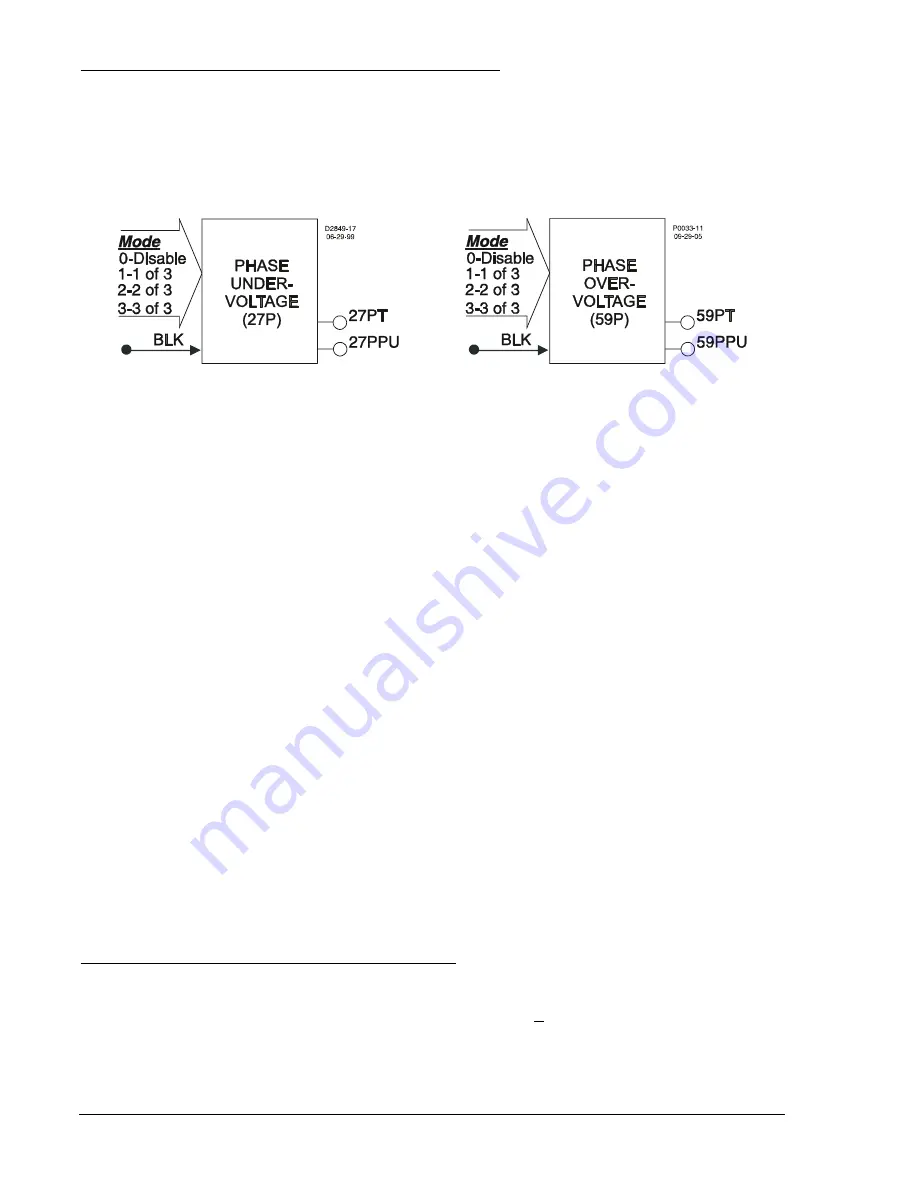
Retrieving Volts per Hertz Overexcitation Status from the Relay
The status of each logic variable can be determined through the ASCII command interface using the RG-
STAT (report general-status) command. See Section 6,
Reporting and Alarm Functions, General Status
Reporting,
for more information. The status can also be determined using BESTCOMS
Metering
screen.
27P/59P - Phase Undervoltage/Overvoltage Protection
Figure 4-37 illustrates the Phase Undervoltage/Overvoltage Logic Blocks. The 127P phase undervoltage
element and the 159P phase overvoltage element are identical in configuration.
Figure 4-37. Phase Undervoltage/Overvoltage Logic Blocks
Each element has two logic outputs:
27PT
(Trip) and
27PPU
(Pickup). When the monitored voltage
decreases below the undervoltage pickup setting (27P) or increases above the overvoltage pickup setting
(59P), the pickup output becomes TRUE and the element starts timing toward a trip. The trip output
becomes TRUE when the element timer times out. The
BLK
(block) input is used to disable protection. A
BESTlogic expression defines how the
BLK
input functions. When this expression is TRUE, the element
is disabled by forcing the outputs to logic 0 and resetting the timer. This feature functions in a similar way
to the torque control contact of an electromechanical relay.
An element is enabled or disabled by the
Mode
input. Any one of four modes is possible for the phase
undervoltage and phase overvoltage elements. Selecting Mode 0 disables protection. Mode 1 activates
protection when one of the three phases of voltage decreases below the pickup setting (27P) or increases
above the pickup setting (59P). Mode 2 requires two of the three phases of voltage to be beyond the
pickup setting. Mode 3 requires all three phases of voltage to be beyond the pickup setting. More
information about logic mode selections is provided in the
BESTlogic Settings for Phase Undervoltage
and Overvoltage
in this section.
The phase undervoltage and overvoltage protective functions each include a timer and three independent
comparators, one for each phase. The 27P/59P functions can be set to monitor VPP or VPN. This is
determined by the 27/59 mode parameter of the phase VT connections setting. For more information on
the VTP setup for PP or PN voltage response, see Section 3,
Input and Output Functions, Power System
Inputs, Voltage Measurement
.
If the 60FL element trip logic is TRUE, and V block is enabled for phase blocking (P), all functions that
use the phase voltage are blocked. For more information on the 60FL function, see the paragraphs later
in this section.
If the target is enabled for the element, the target reporting function will record a target for all phases that
are picked up when the protective function trip output is TRUE and the fault recording function trip logic
expression is TRUE. See Section 6,
Reporting and Alarm Functions, Fault Reporting
, for more
information about target reporting.
When undervoltage inhibit is selected, undervoltage sensing is disabled for any phase that falls below the
inhibit threshold. Undervoltage inhibiting is disabled when the threshold is set to zero. Undervoltage
inhibit is used to prevent undesired undervoltage tripping, such as when a loss of supply occurs.
BESTlogic Settings for Phase Undervoltage/Overvoltage
BESTlogic settings are made from the
BESTlogic Function Element
screen in BESTCOMS. Figure 4-38
illustrates the BESTCOMS screen used to select BESTlogic settings for the Under and Overvoltage
elements. To open the screen, select
Voltage Protection
from the
Screens
pull-down menu, and select
the
27P/127P
or
59P/159P
tab. alternately, settings may be made using the SL-27P and SL-59P ASCII
commands.
At the top center of the
BESTlogic Function Element
screen is a pull-down menu labeled
Logic
. This
menu allows viewing of the BESTlogic settings for each preprogrammed logic scheme. A custom logic
4-42
BE1-CDS240 Protection and Control
9365200990 Rev F
Summary of Contents for BE1-CDS240
Page 2: ......
Page 8: ...vi BE1 CDS240 Introduction 9365200990 Rev F This page intentionally left blank ...
Page 38: ...1 28 BE1 CDS240 General Information 9365200990 Rev F This page intentionally left blank ...
Page 40: ...ii BE1 CDS240 Quick Start 9365200990 Rev F This page intentionally left blank ...
Page 152: ...ii BE1 CDS240 Metering 9365200990 Rev F This page intentionally left blank ...
Page 226: ...iv BE1 CDS240 Application 9365200990 Rev F This page intentionally left blank ...
Page 286: ...ii BE1 CDS240 Security 9365200990 Rev F This page intentionally left blank ...
Page 290: ...9 4 BE1 CDS240 Security 9365200990 Rev F This page intentionally left blank ...
Page 292: ...ii BE1 CDS240 Human Machine Interface 9365200990 Rev F This page intentionally left blank ...
Page 306: ...10 14 BE1 CDS240 Human Machine Interface 9365200990 Rev F This page intentionally left blank ...
Page 308: ...ii BE1 CDS240 ASCII Command Interface 9365200990 Rev F This page intentionally left blank ...
Page 342: ...11 34 BE1 CDS240 ASCII Command Interface 9365200990 Rev F This page intentionally left blank ...
Page 349: ...Figure 12 5 Horizontal Rack Mount Front View 9365200990 Rev F BE1 CDS240 Installation 12 5 ...
Page 361: ...Figure 12 17 Typical DC Connection Diagrams 9365200990 Rev F BE1 CDS240 Installation 12 17 ...
Page 372: ...12 28 BE1 CDS240 Installation 9365200990 Rev F This page intentionally left blank ...
Page 468: ...13 92 BE1 CDS240 Testing and Maintenance 9365200990 Rev F This page intentionally left blank ...
Page 512: ...14 42 BE1 CDS240 BESTCOMS Software 9365200990 Rev F This page intentionally left blank ...
Page 544: ...ii BE1 CDS240 Terminal Communication 9365200990 Rev F This page intentionally left blank ...
Page 550: ...ii BE1 CDS240 Settings Calculations 9365200990 Rev F This page intentionally left blank ...
Page 578: ...D 28 BE1 CDS240 Settings Calculations 9365200990 Rev F This page intentionally left blank ...
Page 579: ......
















































